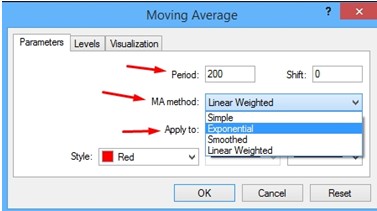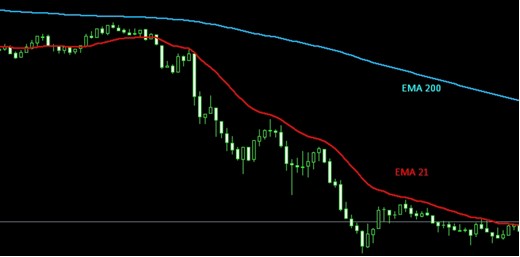Moving Averages for Online Trading – All You Need to Know
We have reviewed many strategies that use moving averages but do you know what a moving average is and how to use it? Believe me, when I say that there are a million uses, it’s not too much of an exaggeration. Moving Averages (MAs), are one of the most basic tools of technical analysis that come in the widest array of variations. They say “the trend is your friend” and a moving average is a tool mainly known for helping you with trend identification but there is much more to it than that.
What is a Moving Average Indicator?
MA, short for moving average, is a standard and very commonly used indicator that many traders use. It can be found on MetaTrader 4 under Insert, Indicators, Trend and Moving Average, it is also available on just about every other charting package in existence. The moving average consists of a line plotted by gathering the data from X number of candles in the past and averaging them together. The end of the line, today’s moving average, is the average price of the asset over the X period. This is the most basic moving average, known as a Simple Moving Average, and even it can be plotted in a number of ways.
For example, you can choose to view the moving average based on candle closes, candle openings, candle highs, lows and even the average price of the candle. The information that a moving average provides helps traders with technical analysis and the interpretation of price action and hence, it is an important tool when creating reliable strategies for all types of trading because MAs can be used just as well for CFDs, Forex, Crypto or binary options. The MA can be set to any time setting you like; the longer the time setting, the more days of data used to make the average, the smoother it will be. The best settings for short term traders are usually below 50 but of course, this differs a lot depending on your strategy and style of trading.
Other variations of moving averages rely on using different methods of analyzing the data. The first and most frequently used is the Exponential Moving Average which gives more weight to more recent data. The Weighted Moving Average gives even more weight to recent data. The Smoothed Moving Average averages the value of the simple moving average and gives a line with less curve. There are many more types of MAs, but the ones I’ve talked about are the most widely spread.
One thing to keep in mind is that a moving average with one setting may equal another moving average with a different setting so it is wise to know what you are looking at. Let me explain; you can convert an SMMA to EMA with the following simple formula: SMMA = 2*X-1 EMA where X is the selected period. Too hard? Try this, to convert an SMMA period 50 to an EMA, replace the X with 50. Therefor: 2*50-1 = 99 which means an SMMA 50 is the same thing as an EMA 99. Now go ahead and plot an EMA 99 and an SMMA 50. What do you see? That’s right, only one line due to the two indicators overlapping each other.

4 different methods, the period and what to apply them to (candle endings, openings and more.)
Different Timeframes, Different Periods
The simplest setting on a moving average is the period, it can be set to any time frame, on any chart, all you have to do is change the period. If you are trading shorter expiries the best choice is to plot moving averages with period 50 or lower. For long term trades, it’s preferred to use moving averages that collect data from 50 candles and above in order to catch longer-term movement. The simplest way to find out which period suits you best is to see how well the moving average line is fitted* to the candles to see if it will create signals as often as you would like. Adjusting the period is like focusing a microscope if you get to close, focus out; if you get too far away from focus in. Using more than one MA on the same chart is a very simple and effective method of multiple time frame analysis.
 *In this M5 timeframe, you see that the EMA 21 is more “fitted” to the lower candle highs and the EMA 200 is not helpful and too far away.
*In this M5 timeframe, you see that the EMA 21 is more “fitted” to the lower candle highs and the EMA 200 is not helpful and too far away.
For trend confirmation when the candlesticks are below the MA, the trend is considered bearish and vice versa for bullish trends. Furthermore, by plotting multiple MAs on the same chart but with different periods you can get stronger signals. Think about it, by using a shorter MA and a longer one you can get the short term and long term diagnosis at the same time! You can see in my example above that the 200 MA shows downtrend and the 21 MA confirms with trend following signals.
How to Use the Moving Average Indicator
Once you have plotted your moving averages, you can use them in several ways depending on your strategy. A moving average will oftentimes intercept a support or resistance line that is well drawn. This is a good confirmation and will signal a price level to execute trades from. The higher period moving averages such as the MA 200 is better for pinpointing stronger support and resistance areas thanks to the many candles that provide the history data. The very short period MA’s however, are better used for trend following and crossover strategies. For example, when a 21 MA crosses a 50 MA from either above or below, it can signal a bearish trade (Sell/Put) or a bullish trade (Buy/Call) depending on which way the 50MA is moving.
Moving averages are also good for trend confirmation. When the longer-term MA is above the shorter and moving down (like in the picture above with EMA 200), the current trend is considered to be bearish and very strong. If the 200 were below the 21 and moving higher the trend would be bullish and strong. On the other hand, if the lines are tangles together or with the candlesticks in an almost horizontal movement, prices are most likely in a ranging market and not trending strongly in either direction. Those times can also be times of market reversal.
Using Moving Averages with Other Indicators!
Moving averages are also the basis for other kinds of tools. The MACD tool, moving average convergence divergence, measures the distance between two different MA’s while cross and move away from each other over and over again. It is a very useful tool for measuring momentum. Moving averages can also create price channels for trading breakouts like the middle line in a Bollinger band. Bollinger Bands ™ use a simple moving average as a midline then project an envelope based on a standard deviation from the MA. Signals are given on midline crossovers as well as when prices reach the edges of the envelope.
A mix of MA’s can also become the basis for a strategy. The Guppy Moving Average is the perfect example of that. This strategy shows how 13 MA’s can create a solid strategy for all kinds of traders. This one uses two groups of MA’s, a short term one and long term one to provide a full range of signals in every time frame.
Moving averages can be complemented with other indicators to make simple or advanced strategies. My favorite indicator to use together with my EMA’s is the Stochastic Oscillator. Since the EMA’s help me confirm my support and resistance lines as I mentioned earlier, the Stochastic is the perfect indicator for additional confirmation for when the candlesticks reach the EMA and my S/R lines. Of course you can select an indicator that you are familiar with or choose one from our tool reviews to try with the moving averages.
Your Turn to Create a Strategy
You now know what a moving average is, you should be familiar with a few different types and know that one can help you identify trends, support and resistance lines and also give signals on crossovers, bounces, and breakouts. Also, it’s very important to know that Moving Averages are a universal tool and they can be tailored to any type of trading and to any asset that can be represented on a chart. If you want to use MAs for stocks, you can. Forex – of course, no problem! Binary Options – Yea! Crypto – for sure! Rule of thumb: if it has a chart, you can slap a moving average on it. If you are still not sure which one to use the best advice I can give you is simply to make an effort and try out various MAs and periods until you find one you like.